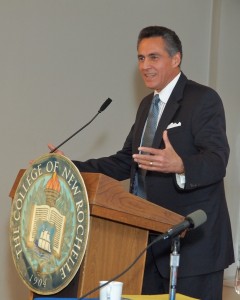
Dan Domenech never claimed to be the bearer of good news.
His recent address to a College of New Rochelle audience at the “Changing Face of Education” forum was no exception, warning that in the current education debate, progress is too closely linked with overzealous cuts.
“For the last three years across the country, education budgets have been going down, down, down,” said the executive director of the American Association of School Administrators (AASA) in Arlington, Va. “They”™re going to go down again this coming school year and the year after that. We will see five years of continuous economic decline and budget declines in education.”
A public education superintendant for 27 years and most recently, senior vice president of national urban markets at McGraw-Hill Education, Domenech accepted his current position in July 2008.
“You”™ll recall that in November (2008) the bottom fell out of the economy,” he said. “Nobody really saw this thing coming down the tracks and we”™ve been in a downward spiral since. In all my years in education, it”™s hard to remember a year when your budget was actually lower than the previous year. That hardly ever happened in education.”
Walter Sullivan, director of The College of New Rochelle Center for Education Policy and Practice, listed the New York State Teacher & Principal Effectiveness Evaluation model as one among many issues affecting students, staff and schools that must be addressed.
“What kind of education do we want for our kids and our grandkids?” Sullivan asked some 150 members of the audience. “We are all invested in the education of our students.”
Gov. Andrew Cuomo proposed recently across the state a $250 million fund for districts demonstrating improvement in student performance. An additional $250 million will be made available for demonstrated cost-cutting measures.
“As a result, you now have the government telling a superintendant and board of education that if you want the money, you have to fire the principal,” Domenech said. “In one of the models, you have to fire half the staff. In another model, you just close the school. Or, you turn it over to a management group or a charter school.”
It is not transformation and it is not reform, Domenech said.
“This is going back to the ”™50s or ”™60s and attempting to do what we did then.”
Domenech said state stabilization dollars and the federal Race to the Top fund will “make this administration the most intrusive administration we”™ve ever had in local affairs.”
Above all else, an “incredible amount of data” will be collected from school districts beginning this July.
The model utilizes standardized test results and student growth as a measure for evaluation of teachers and administrators.
More than 42 states signed on to implement Common Core Standards as part of Race to the Top, but hands were proverbially tied in order to obtain recovery dollars.
“States were supposed to use that money to have the ability to collect data, but they used the money to fill their budget gaps,” Domenech said.
National dialogue has heatedly centered on teacher tenure, seniority and collective bargaining.
“There”™s this whole, ”˜Teachers are the problem and they”™re the ones to blame,”™” Domenech said. “But graduation rates have reached an all-time high. The dropout rate has never been lower. Why are we defining public education based on the 5 percent of schools in this country that are failing?”
















